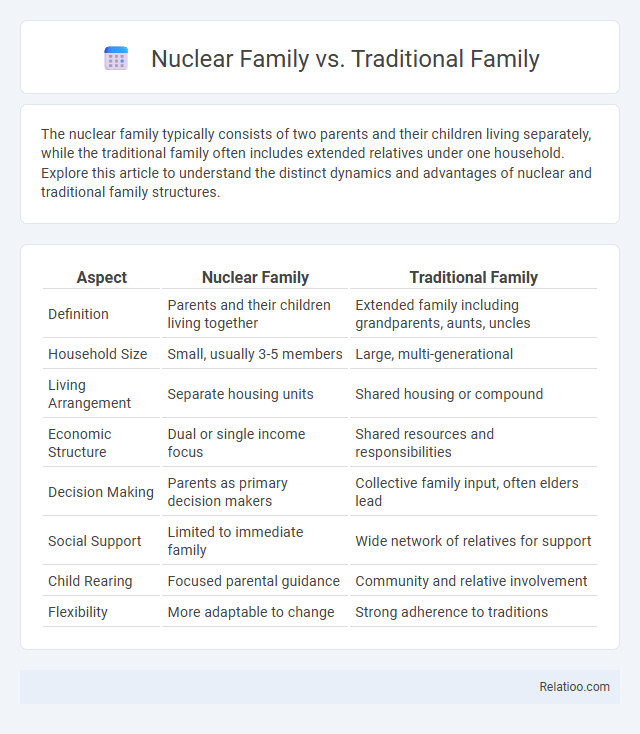The nuclear family typically consists of two parents and their children living separately, while the traditional family often includes extended relatives under one household. Explore this article to understand the distinct dynamics and advantages of nuclear and traditional family structures.
Table of Comparison
| Aspect | Nuclear Family | Traditional Family |
|---|---|---|
| Definition | Parents and their children living together | Extended family including grandparents, aunts, uncles |
| Household Size | Small, usually 3-5 members | Large, multi-generational |
| Living Arrangement | Separate housing units | Shared housing or compound |
| Economic Structure | Dual or single income focus | Shared resources and responsibilities |
| Decision Making | Parents as primary decision makers | Collective family input, often elders lead |
| Social Support | Limited to immediate family | Wide network of relatives for support |
| Child Rearing | Focused parental guidance | Community and relative involvement |
| Flexibility | More adaptable to change | Strong adherence to traditions |
Defining the Nuclear Family Structure
The nuclear family structure consists of two parents and their biological or adopted children living together as a single household unit, emphasizing a distinct family boundary separate from extended relatives. In contrast, the traditional family often includes multiple generations or extended kin living in close proximity or under one roof, reflecting broader social and cultural dynamics. Understanding the nuclear family's definition highlights its focus on parental roles and immediate offspring, shaping modern family functionality and social organization.
Understanding the Traditional Family Model
The traditional family model typically consists of a married heterosexual couple and their biological children living under one roof, emphasizing defined gender roles and intergenerational bonds. Contrastingly, the nuclear family focuses on the immediate family unit, often excluding extended relatives, highlighting autonomy and mobility. Understanding these paradigms reveals how cultural, social, and economic factors shape family structures differently across societies.
Historical Evolution of Family Types
The historical evolution of family types highlights the transition from traditional families, often extended and multi-generational with clear roles tied to agrarian economies, to nuclear families characterized by smaller units focused on parents and children primarily for industrial and post-industrial societies. Traditional families consisted of extended kin networks supporting collective economic activities and social functions, while the rise of nuclear families emerged in the 19th and 20th centuries alongside urbanization and modernization, emphasizing independence and self-contained households. This shift reflects broader socio-economic changes influencing family structures, roles, and functions in contemporary society.
Core Characteristics: Nuclear vs Traditional Families
Nuclear families consist of two parents and their children living under one roof, emphasizing a smaller, more self-contained household unit with direct parental roles and responsibilities. Traditional families often include extended relatives such as grandparents, aunts, or uncles in the household, fostering multi-generational support and shared caregiving. The core characteristic differentiating nuclear from traditional families lies in household structure and the scope of familial involvement in daily life and child-rearing.
Social and Cultural Influences on Family Forms
Social and cultural influences shape family forms by determining roles, expectations, and structures within Nuclear, Traditional, and Extended families. In Nuclear families, common in urban societies, social emphasis on individualism fosters smaller family units with greater independence. Traditional families often reflect cultural adherence to multi-generational living and gender roles, while Extended families maintain strong kinship networks influenced by collectivist cultures and social cohesion values.
Parenting Roles and Responsibilities Compared
Nuclear families typically consist of two parents sharing balanced parenting roles, emphasizing direct involvement in child-rearing and decision-making responsibilities. Traditional families often feature more defined roles, with one parent assuming primary caregiving duties and the other focusing on financial support and authority. Compared to extended family structures, nuclear families prioritize streamlined communication and individualized attention, promoting flexibility but sometimes limiting support networks in parenting.
Emotional Dynamics within Family Structures
Emotional dynamics in nuclear families often center on close-knit relationships between parents and children, fostering strong individual bonds and autonomy. Traditional families, typically extended with multiple generations living together, emphasize collective support, interdependence, and shared responsibilities, which can provide robust emotional security across members. Comparing these to single-parent nuclear families reveals unique emotional challenges and resilience, as single caregivers balance nurturing and discipline roles, affecting attachment and stress levels within the family unit.
Economic Impact of Family Organization
Nuclear families typically exhibit greater economic efficiency due to concentrated income sources and streamlined financial responsibilities, leading to higher disposable income and savings potential. Traditional families, often extended with multiple generations cohabiting, benefit from shared economic resources and diversified income streams, which can reduce individual financial burdens but may dilute overall per capita wealth. The economic impact of family organization influences consumption patterns, housing needs, and social welfare dependency, shaping broader economic stability and growth trends.
Societal Perceptions and Stereotypes
Societal perceptions of nuclear families often emphasize independence, economic stability, and streamlined parenting roles, while traditional families, typically extended or multigenerational, are associated with strong cultural heritage, collective support, and hierarchical roles. Stereotypes about nuclear families include views of emotional distance and reduced social networks compared to traditional families regarded as rooted in communal values but sometimes criticized for rigid expectations. These contrasting perceptions influence social policies, workplace dynamics, and cultural narratives, shaping public attitudes towards family structure and roles.
Future Trends in Family Structures
Future trends in family structures indicate a shift towards more diverse and flexible arrangements beyond the conventional nuclear and traditional family models, incorporating cohabitation, single-parent households, and blended families influenced by societal, economic, and technological changes. The nuclear family, typically comprising two parents and their children, remains prevalent in many societies but faces challenges from increased mobility, digital connectivity, and evolving gender roles that promote shared responsibilities and non-traditional caregiving roles. Traditional family structures, often characterized by extended kin networks and multigenerational living, may see a resurgence in some cultures as economic pressures and aging populations encourage interdependence and support systems beyond the immediate nuclear unit.

Infographic: Nuclear Family vs Traditional Family
 relatioo.com
relatioo.com